It’s ironic that two of the things that make for a family-friendlier vehicle have been disappearing from the market: Sliding – rather than swing-open – doors. And three usable rows of seats – which can be made even more usable by making some of them disappear whenever you need them to.
That vehicle being the minivan – which GM, Ford, Nissan, VW – even Dodge – have stopped making. Chiefly because people are buying what amounts to minivans without the sliding doors or the usable (and stowable) third row.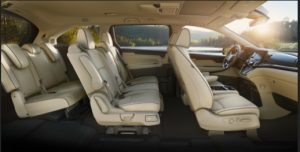
Those vehicles being crossover SUVs – which do their best to be as utilitarian as minivans without looking like minivans.
The problem being they aren’t as utilitarian as minivans – for just that reason.
If you prefer function over form, you’ll be glad to know a few are still available, including the just-updated Honda Odyssey.
What It Is
The Odyssey is a traditional minivan, a type of vehicle currently produced by a diminishing number of car companies, including Honda, Toyota (Sienna), Kia (Sedona) and – for who-knows-how-much-longer – Chrysler (Voyager). Who-knows-how-much longer because Chrysler itself is down to just two models, the Voyager and the 300 sedan. 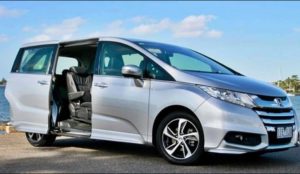
Like the other vans in this class, the Odyssey offers 7-8 passenger seating capacity, depending on the configuration, with unsurpassed access to those rows, the step in height of a car (unlike big SUVs with comparable seating capacity) and the ability to easily transform most of its cargo area into a flat space by disappearing the third row into the floor.
Large SUVs can’t offer this feature because their third rows can’t be folded flat, due to the rear axle that’s under the floor.
Base price is $31,790 for the family-cruiser-intended LX trim. A top-of-the line Elite with a rear seat DVD entertainment system, heated steering wheel and a built in vacuum cleaner – a handy feature other vans don’t offer – stickers for $47,820.
What’s New
All trims come standard with the previously optional Honda Sense suit of driver assistance systems, which includes Forward Collision Mitigation, Lane Departure Mitigation and Adaptive Cruise Control.
What’s Good
Nothing beats dual sliding doors for getting people and stuff in – and out.
Rear seats you can sit in, even if you’re not 12.
Standard V6 in all trims.
What’s Not So Good
Minivans don’t sell well anymore, which makes them harder to re-sell when the time comes.
It’s not so “mini.” The Odyssey has a slightly larger overall footprint than a full-sized SUV like the Chevy Tahoe.
You can’t skip the driver “assistance” tech anymore.
The Odyssey hasn’t yet become a victim of engine downsizing.
It still comes standard with a large (3.5 liter) V6 that makes 280 horsepower without a turbo – because it doesn’t need one.
This fact will possibly make it more appealing to buyers vs. the just-redesigned Toyota Sienna, which no longer offers a V6 at all. The 2021 comes only with a hybrid/four cylinder setup which will advertise slightly better fuel economy but may actually use more fuel on the highway, where the hybrid drivetrain will probably have to work harder to maintain the pace. It could cost more down the road, too – due to the doubled number of parts and the much-increased complexity of the system as well as the hybrid battery that will eventually have to be replaced when it loses its capacity to retain charge.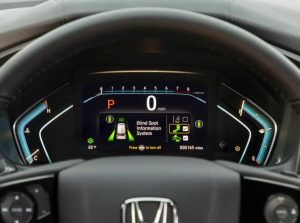
A ten speed automatic is paired with the Odyssey’s V6, which helps it (via multiple overdrive gearing) to deliver 19 MPG in city driving and 28 on the highway. That’s significantly better than the 15 city/21 highway delivered by a full-sized SUV like the Chevy Tahoe.
On the downside, the Odyssey can only pull 3,500 lbs. (vs. 8,600 lbs. for the Tahoe) and it’s front-drive only (no AWD) option – a feature that’s available with the Toyota Sienna – so it’s not much of a trailer-puller or snow-day hauler.
It doesn’t look fast – but that doesn’t mean it’s slow.
In fact, the Odyssey is speedier than some sports cars half its size. It can hustle to 60 MPH in a little over six seconds – which to put the matter in context is speedier than Corvettes were when the first minivans appeared back in the early ’80s.
It’s also speedier than the other vans in the class, including its most on-paper-equivalent rival, the Kia Sedona – which also comes standard with a strong (276 horsepower) V6 (3.3 liters) but needs almost a full second longer to get to 60. This probably has to do with gearing more than weight – because the Kia is only about 70 pounds heavier overall (4,411 lbs. vs. 4,354 lbs. for the Honda).
The Kia has an eight speed automatic with two overdrive gears vs. three in the Honda’s box – which in addition to helping with mileage (the Kia’s is not a little bit lower, 18 city, 24 highway) also helps get two tons-plus of family bus moving speedily since the lower gears are more tightly spaced.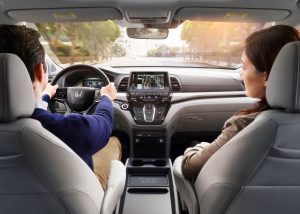
Either that or Honda has fudged the horsepower actually produced by its V6 – or Kia has overstated its number.
Regardless, it can move – which makes it fun as well as family-friendly. No one expects a minivan to be speedy. Especially the drivers of sporty cars, who assume they can snark right by at will. You will also be invisible to cops. Or at least, less visible. Your radar signature will be larger, of course – but the odds of being picked out of a pack for the piece of payin’ paper are smaller and your odds of getting just a warning are probably higher.
Cops feel sorry for minivan drivers. An emotion rarely summoned by the sight of drivers of sporty cars who’ve flouted the speed limit.
It is also supremely comfortable – for eight people. Minivans have become RV alternatives as much as kid-conveyors. Few vehicles are better suited to cross-country driving – without putting on a ‘hurting – than a new minivan.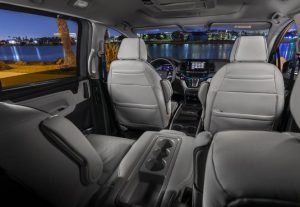
And while it’s big, it’s also low. Unlike SUVs, in which you sit up high. And climb over as well as up to get into the seats. Not everyone wants that – and the only way to avoid that while still having the ability to carry eight without contortions is by getting something like this.
One thing you also get – mentioned earlier – is the array of driver “assistance” tech, which is no longer optional. Which is unfortunate – if you don’t need the “assistance.” These systems are being hard-sold to the public via use of adjectives such as “advanced” – but they’re frankly retarded in that that they cannot – among other failings – discern the difference between an intended lane change and a wandering into the other lane change. If you fail to signal a turn, even though no other car is near, the Lane Departure Mitigation will try to steer you back into your lane.
Similarly, the Forward Collision Mitigation – Honda’s term for automated emergency braking – will sometimes brake when there is no emergency, as when a car up ahead is stopped but obviously (to you, the driver) in the process of exiting the road, but the “advanced” assistance system doesn’t have the refinement to discern this and jams on the brakes regardless.
These systems can be turned off – which is good. But it’d be better if Honda let buyers decide whether they want the “assist” in the first place. Here, the Kia Sedona has the advantage, if you’d rather drive without “assistance.” These features are available in the Sedona – but they are still happily optional.
The Odyssey tries harder to not look like a minivan than the others in the class. It almost looks like a kind of super-sized Accord – outside and inside. Which is to say, it looks pretty nice, especially in view of the parameters.
You can only do so much with the shape without impinging on the form. Honda did a credible job of pushing the styling envelope about as far as is it could be pushed.
A word on words.
The original minivans were just that.
Not much larger than a family car of the era – being based on family cars of the era like the K-car, which served as the foundation of the first mass-market minivans from Dodge and Plymouth (RIP).
The Odyssey is larger – overall – than a current full-size SUV like the Chevy Tahoe, which is only 204 inches long vs. 205.2 inches for the Odyssey.
But it can do things the full-size SUV can’t – such as disappear its third row entirely into the floor -and nothing competes with sliding door access to all three rows.
Except, of course, another minivan.
Here, again, the Kia Sedona has a little bit of an edge – because it is not quite as large overall. At 201.4 inches end to end, it’s smaller overall than the Tahoe, too. But the price you pay for that is what you’d expect:
A less-roomy inside.
The Odyssey has the most room inside in the class – 155.7 cubic feet vs. 142 for the smaller-on-the-outside Sedona, 140.5 for the Chrysler Voyager and 150 cubic feet for the 2020 Sienna (2021 specs weren’t available when this review was written and it is possible the hybrid 2021 Sienna will have less cargo capacity than the outgoing model because of the room which the hybrid battery/motor system will necessarily consume).
And – to revisit the cross-species comparison – the Tahoe’s maximum cargo capacity is a comparatively puny 94.7 cubic feet – with just 15.3 cubic feet behind its very tight third row – vs. 38.6 cubic feet behind the Odyssey’s adult-viable third row.
The Honda is arguably the nicest van in the class – and this is reflected by its price, which is higher to start than the Sedona’s as well as the Voyager’s. But you get what you pay, including standard automatic climate control AC (vs. manual), high-output LED headlights and a very nice standard seven speaker stereo.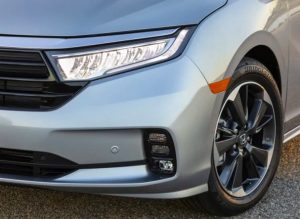
One thing you don’t get for your money – unless pay some more money – is AppleCarPlay and Android Auto, which don’t come standard in the base LX trim. You have to move up to the more expensive EX ($35,190 to start) to get them. The desirable power rear liftgate is also extra-cost, but you can outfit this rig with Winnebago-esque luxuries such as ambient interior mood lighting, a cabin intercom system and an 11 speaker premium audio system.
The others offer similar amenities, of course – but none of them can match the Odyssey’s performance.
Or its spaciousness.
There is an upside to being not-so-popular. It is being in a better position to haggle. It is probable you’ll be able to buy a new Odyssey for less than what you’d end up paying for something otherwise comparable but more popular – and without the handiness of those sliding doors.
And those disappearing third row seats.
The Bottom Line
Minivans may not be exactly sexy – but they still have their attractions.
. . .
Got a question about cars, Libertarian politics – or anything else? Click on the “ask Eric” link and send ’em in!
If you like what you’ve found here please consider supporting EPautos.
We depend on you to keep the wheels turning!
Our donate button is here.
If you prefer not to use PayPal, our mailing address is:
EPautos
721 Hummingbird Lane SE
Copper Hill, VA 24079
PS: Get an EPautos magnet or sticker or coaster in return for a $20 or more one-time donation or a $10 or more monthly recurring donation. (Please be sure to tell us you want a magnet or sticker or coaster – and also, provide an address, so we know where to mail the thing!)
If you’d like an ear tag – custom made! – just ask and it will be delivered.
My latest eBook is also available for your favorite price – free! Click here. If that fails, email me at EPeters952@yahoo.com and I will send you a copy directly!





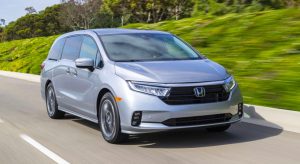

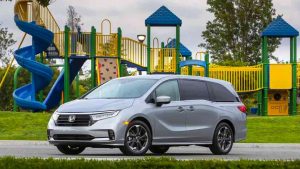








Hi. Thank you for your detailed and very useful review of the 2021 Honda Odyssey. The current car market is very strange, with used vehicles selling for higher prices than new ones (at least in our state, North Carolina)… Consequently, we are looking more at buying a new car than a used one. Do you have any insights on the 2022 model (or perhaps a full review in the coming days or weeks)? We would like to make sure that not that many features have changed/worsened since the 2021 version. Thank you again for your wonderful website!
Thanks for the kind words, Patrice!
Good news: The ’22 Odyssey is a “carryover” – which means it is essentially the same as last year’s model (and going back to the last redesign, in 2018). The major “change” for ’22 is that the factory vacuum cleaner accessory is no longer offered. But the superb 3.5 V6 is still standard!
Great, thank you so much for your quick response! Wishing you a great day,
Patrice
Price sells vehicles, period. When I had to buy the new family wagon/truckster, i n spring 2008, I created a decision matrix, analyzing MPG, price, carrying and towing capacity, and a few other items. I would have preferred the Dodge, at $18-22K, but wifey won, got the Chrysler town and country, in the new (08) body style, for $24,600. The Honda ran $29-37K, and Toyota was $32-41K. No one else offered a lifetime, closest was Kia, with a 100K warranty, at $22-28K. Got the lifetime warranty on everything, for about $2500, bought the loss leader vehicle in the showroom, with all the DVD, satellite radio, remote doors, and video game plug ins. The warranty has paid for itself in spades, having had about $10K in warranty work done so far, with only 145K miles or so. The engine, a 3.8L in V6, drinks oil like a drunken sailor, but still pulls like a champ. The transmission, which has been the greatest source of bad press for Chrysler, and my biggest worry, has been the best thing, no problems at all, just fluid and filter changes. Overall, some aggravating issues, being that it is a Chrysler, but i have been duly impressed by it’s ability to keep on rolling. Interestingly enough, Chrysler stopped offering the lifetime warranty on everything in 2011 or 12, since it was killing their bottom line. It was basically a marketing gimmick, since their surveys showed after 6 years, 95% of owners had sold or traded the vehicles, and the warranty only applied to original owner who bought it new. Chrysler is going to lose their shirt on me, and they’ve already done so. I will probably drive it til 2038, lol, if not longer.
I had a ’99 Toyota Sienna 20 years ago or so. It replaced an Astro. I missed the Astro’s room but not the flaky Chevy issues. At one point, I was laid off and became the housewife. Felt like one drving that thing. Like I ought to be wearing a sundress.
As an aside, it was a great job. These women that complain are nuts.
Anyhow, I’m in DFW where they issue soccer moms Tahoes and Expeditions. So I rock up to school, hit the button – bomb bay doors open – the kids run out, I hit the button and the bomb bay closes. And I wait for the soccer mom ahead of me to waddle around her tahoe to shut the door the kids left open.
I remember, at least twice, cussing to myself about the dealer bill, then looking up at the odometer and realizing the damn thing hadn’t costed me cent in nearly 50K miles. The thing never broke, and had nothing but maintenance the whole 200K miles until I traded it in for a 4Runner, The single best truck I’ve ever owned.
Other than the estrogen factor, the only complaint I had really was the 1MZ 3L v6. It was anemic in every Toyota/Lexus I’ve ever owned with that motor. I had to tow a trailer a few times with it. Acted like a cat on a leash, but it still did it OK.
I was quite fond of my 2001 Odyssey. I bought it in 2013 with just 59k miles on it, gently loved by a retired physician and his wife who decided that it was time to stop driving.
The one thing I hated about it, was the power sliding doors. Those familiar with that version of the Odyssey know that the cable system tends to bind up, often requiring someone applying force from the outside to either open or close the doors. It was a major inconvenience.
That problem was solved on 10/6, when it was parked on a quiet one block long street, and someone managed to hit it and total it, with just 127k miles on the clock.
Hi Kevin,
I personally prefer manual sliding doors for this reason though I understand that power doors are a convenience and even necessary for people who haven’t got the strength to open them manually. Still, some of us do – and it’d be nice if you could skip the power feature (which is also glacially slow – for saaaaaaaaaaaaaaaaaaaaaaaaaaaaaaaaaaaaaaafety) and opt for manual doors.
Between my former 2003 Odyssey EX-L and my current 2012 Odyssey EX-L, we’ve put over 250,000 miles on J35 Odysseys. The engines are workhorses with plenty of power. My kids are seniors in High School, so my wife is about to graduate to the vehicle of her choice next. She’s been driving the haulers for 18 years now. Aside from some weirdness in the front end of my current car, they’ve been workhorses. And the resale value has been pretty good.
Honda Odyssey is not what I want for a vehicle.
The Plymouth Voyager I owned had a malfunction of the electronics in the sliding door and the thing was dinging while driving down the road. It was very annoying and some kind of fix was necessary.
I sold it and bought a Suburban.
The ‘spider’ failed in the Suburban while driving through the Black Hills in Wyoming right near the border with South Dakota. There was nothing, no power, no brakes, no steering, had I not been going uphill at the time, I would have had to use my emergency brake fast.
Cost me 2600 hundred dollars plus a thirty mile tow to Newcastle. It was late at night, there was a bar a few hundred yards away for some help, which we got, my wife and I drank a beer while waiting for the tow truck.
Two years later, the same thing happened to the ‘spider’. The Suburban is junk now, too many miles. Great truck though, wish I had a new at times but the Suburbans these days are not what I want to see in vehicle design, they’re ugly, in my humble opinion.
The Pathfinder has been good and is now my the most favorite vehicle I have ever owned.
Minivans have also become waaaay more expensive than the original iteration. In 1984, a base Plymouth Voyager cost $9100, correcting for inflation (more precisely, the federal government’s fiat money tax), in 2020 dollars it’s $22,796.42. So, a base Honda Odyssey at $32K is quite a jump. Yeah, the 2020 version has a lot more power, can tow, is bigger, etc. But, why is it I can’t get a mini-minivan that costs more like $22K? Regulations, crash-worthiness, all that plays into it, of course, since a 1984 Voyager was a “truck” for Uncle’s regs, and the 2020 equivalent is a passenger car.
On the other side of the equation, why is it families in 2020 can “afford” $32K when (I was at that point in 1986, I can relate to this one!) families in 1984 were really squeezing to make the payments on $22K in today’s dollarettes? A whole lot of families could not, and made do with a downsized family sedan at a lower pricepoint.
The closest thing to an 1980’s minivan (size and almost price) is the Ford Transit Connect. Ford calls it a “wagon” but its a minivan.
“It’s ironic that things that make for a family-friendlier vehicle have been disappearing from the market: Sliding – rather than swing-open – doors.”
It’s a cultural thing. Visit Japan and you’ll notice that every commercial establishment, from the largest to the smallest, has automatically-activated, dual-leaf sliding doors.
Meanwhile, a nation which sanctimoniously declared “accessibility” a national policy via the ADA 30 years ago obstinately sticks to hinged doors even in the busiest of entrances, such as many post offices. People using walkers, crutches or wheelchairs are inconvenienced or even excluded. And those who don’t still face awkward encounters involving who goes first, or who holds the door for whom.
Japanese culture is all about convenience, down to the smallest aspects of life. Vending machines are omnipresent (even for beer), and they never eat your money. Whereas what motivates American culture remains inscrutable, even to those who were raised here. Strange country …
“Japanese culture is all about convenience, down to the smallest aspects of life.”
Amen, including the Toto Apricot Washulet!
https://www.youtube.com/watch?v=4CpftkjHM7w
https://www.youtube.com/watch?v=oZrmKgkQFnI
That one with the frog and chicken makes me bust out laughing every time I see it.
OT:
Eric, do you have any insight/inside info on the rumored Ford Maverick/Courier unitbody pickup truck?
Hi X,
Yes; it – the Maverick – is apparently going to be a Subaru Baja-like vehicle, which means a four door car-like crossover with a small bed in the back. The Subaru failed – though I personally like it. But I’m a kook – so don’t go by me.